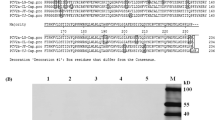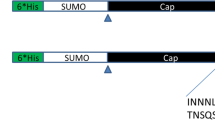Abstract
The swine pathogen porcine circovirus type 2 (PCV2) causes significant economic damage worldwide. The PCV2 capsid (CP) residues 169-STIDYFQPNNKR-180 have been identified as a decoy epitope that diverts the host immune response away from protective epitopes. However, the decoy epitope may include important linear or conformational protective epitopes against PCV2. In this study, we used the baculovirus system to express recombinant complete CP (1–233) and mutant CP (Δ169–180), in which the decoy epitope was deleted, and evaluated the immune response to these in mice. Immunization with mutant CP (Δ169–180) protein, which formed very low level of virus-like particles (VLPs), elicited significantly lower levels of PCV2 CP-specific IgG antibodies and a slightly lower neutralizing activity than immunization with the complete CP (1–233) protein. This finding suggests that the complete CP is important for efficient VLP assembly and induction of PCV2-specific IgG antibodies and neutralizing antibodies in mice. This study may provide useful information for next-generation vaccine design for PCV2 control.



Similar content being viewed by others
References
Davies B, Wang X et al (2016) Diagnostic phylogenetics reveals a new porcine circovirus 2 cluster. Virus Res 217:32–37
Dustin LB, Cashman SB et al (2014) Immune control and failure in HCV infection-tipping the balance. J Leukoc Biol 96(4):535–548
Fu Y, Jiang L et al (2017) Immunomodulatory and antioxidant effects of total flavonoids of Spatholobus suberectus Dunn on PCV2 infected mice. Sci Rep 7(1):1–9
Ilha M, Nara P et al (2020) Early antibody responses map to non-protective, PCV2 capsid protein epitopes. Virology 540:23–29
Jin J, Park C et al (2018) The level of decoy epitope in PCV2 vaccine affects the neutralizing activity of sera in the immunized animals. Biochem Biophys Res Commun 496:846–851
Khayat R, Brunn N et al (2011) The 2.3-angstrom structure of porcine circovirus 2. J Virol 85(15):7856–7862
Kim K, Choi J et al (2018) Genetic variations in open reading frame 2 gene of porcine circovirus type 2 isolated in Korea during 2016–2017. Korean J Vet Res 58(3):143–146
Kim S, Nazki S et al (2018) The prevalence and genetic characteristics of porcine circovirus type 2 and 3 in Korea. BMC Vet Res 14(1):294
Lekcharoensuk P, Morozov I et al (2004) Epitope mapping of the major capsid protein of type 2 porcine circovirus (PCV2) by using chimeric PCV1 and PCV2. J Virol 78(15):8135–8145
Liu L, Suzuki T et al (2008) Efficient production of type 2 porcine circovirus-like particles by a recombinant baculovirus. Arch Virol 153(12):2291
López-Vidal J, Gómez-Sebastián S et al (2015) Improved production efficiency of virus-like particles by the baculovirus expression vector system. PLoS ONE 10(10):e0140039
Madson DM, Opriessnig T (2011) Effect of porcine circovirus type 2 (PCV2) infection on reproduction: disease, vertical transmission, diagnostics and vaccination. Anim Health Res Rev 12(1):47–65
Mahe D, Blanchard P et al (2000) Differential recognition of ORF2 protein from type 1 and type 2 porcine circoviruses and identification of immunorelevant epitopes. J Gen Virol 81(7):1815–1824
Masuda A, Lee JM et al (2018) Purification and characterization of immunogenic recombinant virus-like particles of porcine circovirus type 2 expressed in silkworm pupae. J Gen Virol 99(7):917–926
Mo X, Li X et al (2019) Structural roles of PCV2 capsid protein N-terminus in PCV2 particle assembly and identification of PCV2 type-specific neutralizing epitope. PLoS Pathog 15(3):e1007562
Segalés J, Kekarainen T et al (2013) The natural history of porcine circovirus type 2: from an inoffensive virus to a devastating swine disease? Vet Microbiol 165(1–2):13–20
Shang S, Jin Y et al (2009) Fine mapping of antigenic epitopes on capsid proteins of porcine circovirus, and antigenic phenotype of porcine circovirus type 2. Mol Immunol 46(3):327–334
Stamatatos L, Morris L et al (2009) Neutralizing antibodies generated during natural HIV-1 infection: good news for an HIV-1 vaccine? Nat Med 15(8):866–870
Szczepanek SM, Barrette RW et al (2012) Xenoepitope substitution avoids deceptive imprinting and broadens the immune response to foot-and-mouth disease virus. Clin Vaccine Immunol 19(4):461–467
Thaa B, Sinhadri BC et al (2013) Signal peptide cleavage from GP5 of PRRSV: a minor fraction of molecules retains the decoy epitope, a presumed molecular cause for viral persistence. PLoS ONE 8(6):e65548
Trible BR, Kerrigan M et al (2011) Antibody recognition of porcine circovirus type 2 capsid protein epitopes after vaccination, infection, and disease. Clin Vaccine Immunol 18(5):749–757
Trible BR, Rowland RR (2012) Genetic variation of porcine circovirus type 2 (PCV2) and its relevance to vaccination, pathogenesis and diagnosis. Virus Res 164(1–2):68–77
Trible BR, Suddith AW et al (2012) Recognition of the different structural forms of the capsid protein determines the outcome following infection with porcine circovirus type 2. J Virol 86(24):13508–13514
Worsfold CS, Dardari R et al (2015) Assessment of neutralizing and non-neutralizing antibody responses against Porcine circovirus 2 in vaccinated and non-vaccinated farmed pigs. J Gen Virol 96(9):2743–2748
Wu P, Lin W et al (2012) Characterization of porcine circovirus type 2 (PCV2) capsid particle assembly and its application to virus-like particle vaccine development. Appl Microbiol Biotechnol 95(6):1501–1507
Xu X, Wang Z et al (2012) Baculovirus as a PRRSV and PCV2 bivalent vaccine vector: baculovirus virions displaying simultaneously GP5 glycoprotein of PRRSV and capsid protein of PCV2. J Virol Methods 179(2):359–366
Yu C, Li X et al (2016) Replacing the decoy epitope of PCV2b capsid protein with a protective epitope enhances efficacy of PCV2b vaccine. Vaccine 34(50):6358–6366
Yu S, Carpenter S et al (2005) Development of a reverse transcription-PCR assay to detect porcine circovirus type 2 transcription as a measure of replication. J Virol Methods 123(1):109–112
Acknowledgements
We would like to thank Mrs. Eunjin Hong (Innovac Co.) for technical assistance.
Funding
This study was funded by Small and Medium Business Administration (Grant no. S2785512).
Author information
Authors and Affiliations
Corresponding author
Ethics declarations
Conflict of interest
The authors declare that they have no conflict of interest.
Additional information
Handling Editor: Ana Cristina Bratanich.
Publisher's Note
Springer Nature remains neutral with regard to jurisdictional claims in published maps and institutional affiliations.
Electronic supplementary material
Rights and permissions
About this article
Cite this article
Kim, K., Shin, M. & Hahn, TW. Deletion of a decoy epitope in porcine circovirus 2 (PCV2) capsid protein affects the protective immune response in mice. Arch Virol 165, 2829–2835 (2020). https://doi.org/10.1007/s00705-020-04831-z
Received:
Accepted:
Published:
Issue Date:
DOI: https://doi.org/10.1007/s00705-020-04831-z





